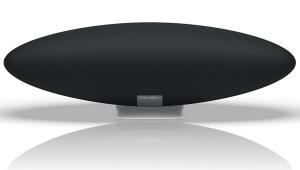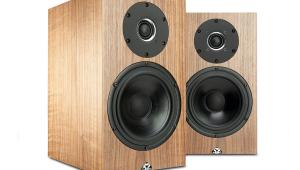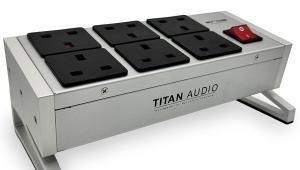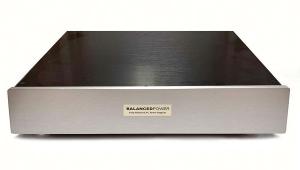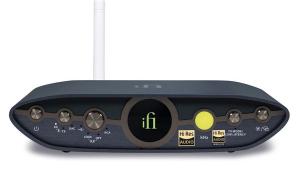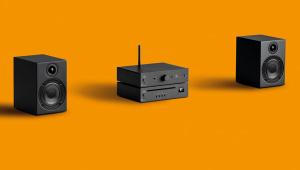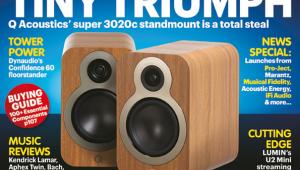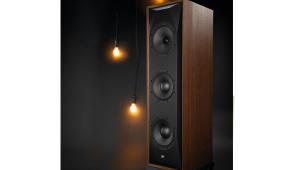KEF LS50 Wireless II

 KEF has traditionally focused on more conventional passive speakers for the bulk of its product lines. Its decision to create an active version of the LS50 was shaped not so much as a challenger to more conventional active rivals, but to create a self-contained system built around one of its most successful recent designs. With the passive LS50 receiving a selection of enhancements, KEF has applied these to the active version, creating the LS50 Wireless II.
KEF has traditionally focused on more conventional passive speakers for the bulk of its product lines. Its decision to create an active version of the LS50 was shaped not so much as a challenger to more conventional active rivals, but to create a self-contained system built around one of its most successful recent designs. With the passive LS50 receiving a selection of enhancements, KEF has applied these to the active version, creating the LS50 Wireless II.
The Wireless II takes the same raw ingredients as the passive LS50 Meta. It uses a single 150mm Uni-Q driver in each cabinet. Now in its 12th generation, the process of mounting a 25mm tweeter in the centre of the mid/bass driver improves the dispersion, imaging and phase characteristics of both drivers and, thanks to KEF’s ongoing work with waveguides, surrounds and bracing, the bulk of these notional benefits are now largely realised. This latest generation of Uni-Q makes use of what the company calls Metamaterial Absorption Technology. This consists of a circular plate of metamaterials that reduces unwanted reflections coming back through the driver.
To make the LS50 active, KEF fits no less than 380W of amplification per speaker, with 100W allocated to the tweeter and 280W to the mid/bass driver. The design is a true active, with a DSP-based crossover called a Music Integrity Engine that allows for user adjustment to fit the space and position that the speaker is being used in. This hardware is mounted in the same cabinet as the passive version. This is designed around the principle of a massively stiff glass fibre and polyester front baffle that curves away from the driver itself to assist its already excellent dispersion characteristics.
Key to the KEF’s operation is that while it has a solitary analogue connection via a 3.5mm input, it should be seen more like an all-in-one system. It’s fitted with a 24-bit/384kHz-capable UPnP streamer combined with a coaxial digital, optical and HDMI ARC connection. You can wirelessly stream to the LS50 Wireless II via AirPlay 2, Google Cast and Bluetooth 4.2. KEF has also ensured that it’s Roon Ready. Connections are fitted to one speaker, which then communicates with the other via either an RJ45 umbilical or – new for the Wireless II – via wireless at a 24-bit/96kHz sample rate. I have some minor dropout issues with wireless pairing, so opt to use the tether while testing.
Control options are usefully flexible. The master speaker has a selection of hard controls on a touchpad on the top and comes supplied with a remote handset that allows for day-to-day requirements; volume, input selection, play/pause etc. to be made without having to open an app. This is beneficial because the app itself has some limitations. On the plus side it’s considerably better than the older version used by the original LS50 Wireless and LSX (HFC 446), but it’s not without its foibles; somewhat limited browsing of a library on the same network being the main one. On the plus side, streaming service access is comprehensive (and for Tidal users, the Wireless II is MQA compatible) and the app itself is stable and logically laid out. It isn’t terribly pretty, though, feeling a generation behind some more mainstream rivals in this regard.
It gives away rather less in terms of design and build, however. The striking and distinctive design of the LS50 is unchanged and this means it will be seen as a bit of a Marmite product by a few would-be owners, but the decent choice of different colour finishes goes a long way to alleviating that. The build quality is also outstanding. The cabinet feels incredibly solid and the implementation of details like the touch panel on the master speaker are also done to a very high standard. This isn’t a cheap product by any means, but you can see where the money has gone.
Sound quality
With the cabinets running wired both to my network and to each other and making use of Roon as a control point, the most obviously immediate impression is one of effortlessness. The passive LS50 Meta benefits from being used with a reasonably powerful amplifier and the 380W on hand to drive the active version never feels too much. Pushed very hard indeed, the KEF can harden up a little but any volume levels you’ll be hitting at this point will be seriously anti-social anyway.
Used within its considerable operating envelope, the LS50 Wireless II delivers on the design premise of both the driver and mounting. So long as your position relative to it forms a rough triangle, it images in a way that is beyond many rival stereo systems and leaves any one-box rival standing. The 24-bit/96kHz Qobuz stream of Dead Sea by Paris Jackson sees her vocals pushed forward and to the centre while the supporting instrumentation is arrayed around her in a space that extends both up and out from the cabinets themselves.
Where the active speaker makes clear gains over its passive relative is the tonality and richness it offers. While I am left feeling that some care will need to be taken with any partnering equipment with the LS50 Meta, the tonal balance of the Wireless II is extremely well judged. The sumptuous 24-bit/96kHz download of Star’s Losing To You is well controlled and believable and leaves Torquil Campbell’s lovely vocal turn sounding rich and emotional. But even when you change tack entirely and move to the crunching aggression of Royal Blood’s Boilermaker, things remain civilised without losing the all-important boisterous energy of the track.
Something else that Royal Blood demonstrates is that the LS50 has phenomenal bass extension for a relatively small cabinet. The grunt of that on-board amplification is enough to ensure that the KEF never fails to deliver bass you can feel as much as hear. No less importantly, this bass is fast, controlled and detailed. I have best results telling the Music Integrity engine the speakers are closer to the wall than they actually are. This sees a fractional drop in low-end extension but tightens things up to the point where no time signature I listen to throws it off. Something else the KEF does very effectively is to ensure that all its functionality feels usable and usefully equivalent in performance terms. Sure, streaming Deezer over AirPlay lacks some of the definition and richness of Qobuz over UPnP, but the experience is more than listenable. The only real note of caution I’d extend with the wired functionality is practical rather than performative. With the inputs on the back of the speaker, some thought is going to have to be given to ensuring that your sources can reach it in a tidy fashion. Features like the HDMI ARC work well under test, though.
Conclusion
It’s this strength in depth that makes the KEF so convincing. I still feel that a few little tweaks to the software would reap benefits, but I can’t argue with the way it combines an extensive and practical specification that makes it an ideal one-stop shop with a level of overall performance that is truly outstanding. When you listen to the LS50 Wireless II it’s easy to forget about the convenience angle and concentrate instead on the sensational level of sonic performance. It isn’t cheap, but it’s unquestionably a superb all-in-one system that should be on anyone’s shortlist at or near the price. ES
DETAILS
Product: KEF LS50 Wireless II
Type: Wireless active loudspeaker
FEATURES
● 380W internal amplification
● 24-bit/384kHz and DSD128 compatible
● Inputs: coaxial; optical; analogue
● AirPlay 2, Google Cast and Bluetooth
● Roon Ready
 |
Inside this month's issue:
Ruark R610 music system and Sabre-R standmount speakers, PMC twenty.23i Active, floorstanders, English Acoustics Downton preamplifier, Bluesound NODE ICON preamp/streamer, Ortofon Concorde Music Blue MM cartridge and much, much more
|
